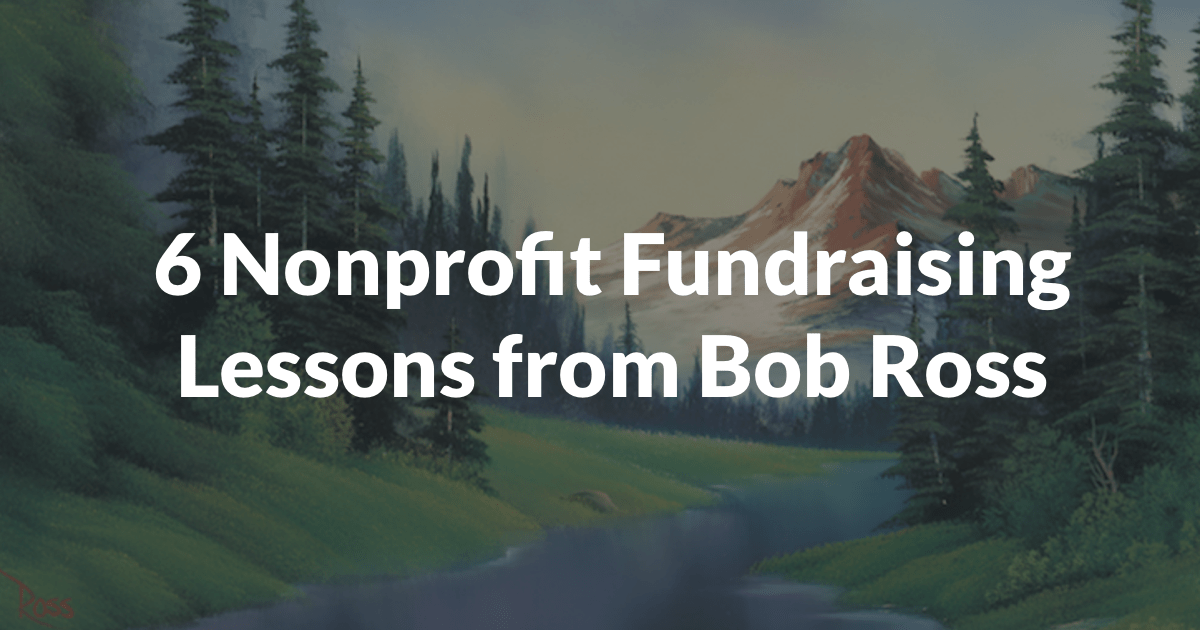6 Nonprofit Fundraising Lessons from Bob Ross

We could all learn a lot of valuable lessons from Bob Ross. The first impression he made was positive and uplifting, but it went deeper than that. By freely sharing a specialized skill he possessed by breaking it down step-by-step and making it accessible to everyone via public television, he was a leader in the DIY space. (And he had excellent branding to boot.) The ways in which he approached his work can be instructive for nonprofits of all stripes, from internal strategy to marketing, so let’s dive into this happy little pond of wisdom together.
1. There are no mistakes, just happy accidents
We don’t mean to say that changing how you see adversity cures all ills, but the famous Bob Ross approach to an “oops” has some very specific potential.
Organizationally, interrogating how your group sees the concept of failure won’t do the hard work of fixing the world’s problems, but it might help you bounce back from missteps more quickly in order to keep doing your vital work. Taking reasonable risks should be rewarded!
When it comes to staff morale and office culture, this approach can encourage nonprofit staff carrying (metaphorically) heavy weight on your shoulders to treat yourselves kindly as you attempt to solve deeply-rooted social problems before your next meeting. Regardless of the specific circumstance, it can be reassuring to think of errors not as the end of the world, but as happy accidents, and that’s something Bob Ross knew that all too well.
2. Never underestimate the power of DIY
Every nonprofit staffer knows that scrappiness is a welcome and necessary part of doing this work. Whether you’re setting up an event all by yourself or frantically mopping up water from an overflowing pipe before it hits the server room (true story), you and your coworkers probably embody the often-repeated nonprofit job description phrase “other duties as assigned.” This is the ultimate DIY ethos, and you know it well.
Outside of one-off occasions when you’ve got to put out a fire even if it’s not really in your scope of work, it’s important to share that DIY spirit and use it to empower and de-silo yourselves at work – what information and skills can you share with other departments? Who else can learn a specialized skill? What projects can you collaborate on, rather than complete by yourself? In the long run, this DIY ethos will help ease everyone’s workloads as you learn from each other and, therefore, rely less on specific people to know specific things.
3. Commit to the bit
We won’t lie to you: #branding matters. Being consistent in the way you look, sound, and act allows people to get to know you and build a sense of familiarity with your work. Bob Ross was no stranger to expert branding: his signature phrase when adding new elements to his paintings’ skies was ‘happy little clouds’ (a style guideline!). He often used the same paint color palette (brand colors!). Lastly, he often painted the same type of scene in each episode (a well-defined issue area!). In short: consistency will help you carry out your mission more effectively.
(As a side note, Bob Ross even kept his signature perm after he grew to dislike it, because it was part of the logo. We don’t think you’ll have to alter your sartorial choices to develop brand consistency – you should do just fine examining your work product! – but we have to admire that level of commitment.)
4. Connect with people one-on-one
The power of Bob Ross’s The Joy of Painting was his ability, essentially, to vlog before vlogging was cool: he came right into your living room and gave a little one-on-one painting lesson. He was approachable without being overly glib or gimmicky, and for those who had never painted before, this made painting feel like it was possible even without formal training. Nonprofit staff can channel the power of one-on-one chats by sitting down with volunteers who have never canvassed before or donors who aren’t familiar with your work (yet!) in order to build stronger bonds with them. That interpersonal connection is worth every second you invest in it.
5. Courage and flexibility
Whether you’re making a big ask of a major donor or blending a little Alizarin Crimson in with your Phthalo Blue to paint a happy little lake, it’s wise to take risks. If you’re painting along and you notice the trees would really benefit from some happy little leaves, throw ’em in there! Broadly speaking, let yourself be brave and make informed decisions if you notice changes need to be made.
6. Keep the big picture in mind
Focusing on small details like your crosshatch painting technique is important, but what’s the end goal? You want a beautiful picture of a serene world, both on your canvas and in real life. If you’re a nonprofit, you need funding to make that happen. When you write your grant proposals and reports, make sure you’re painting a cohesive picture of your work. The danger of getting so caught up in tiny details and neglecting the overall vision is that your audience (a funder, a donor, or a volunteer) stops being able to see the forest for the (happy little) trees. And we know the world’s potential is too beautiful to miss out on capturing it in our art or putting a plan into action to make it even better.
While Bob Ross may have decided to keep his perm, nonprofits do need to keep up with the times. Check out our guide to 2020’s biggest nonprofit fundraising trends to make sure that your program carries on timeless values with modern techniques.


